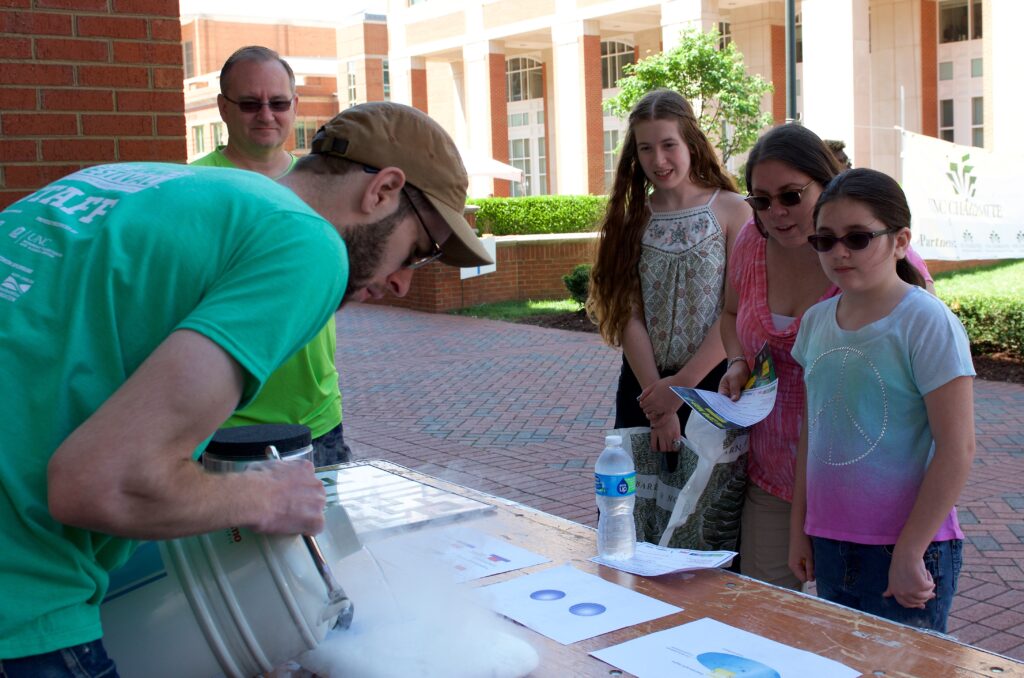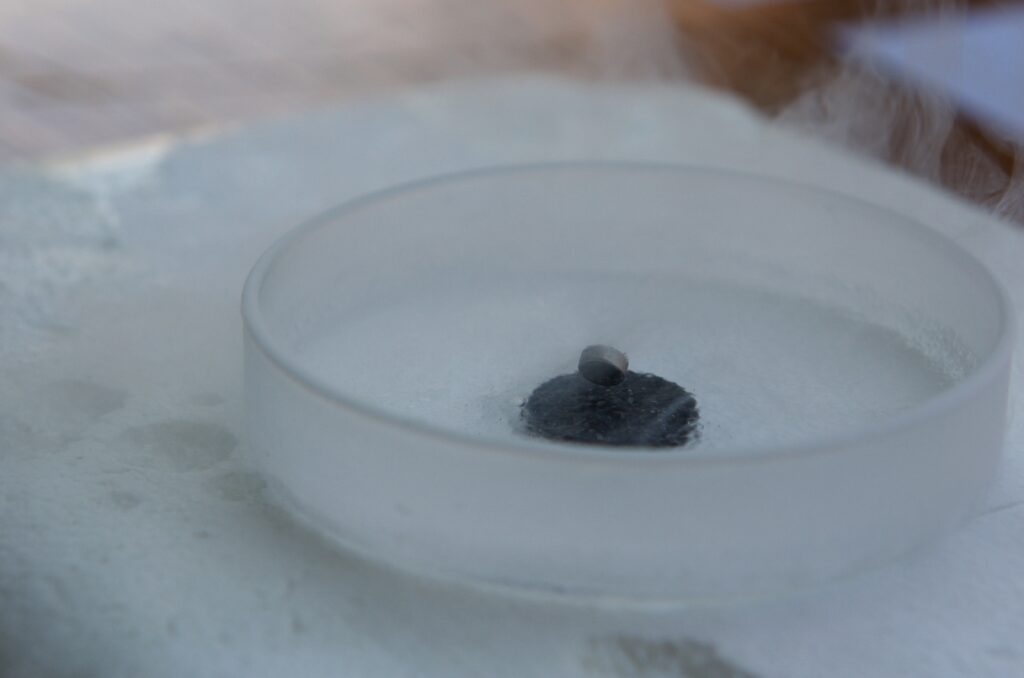UNC Charlotte Biology, Psychology Major Accepted By 10 Highly Ranked Medical Schools
Levine Scholar Andrea Badillo-Pérez will pursue her passion for service as she heads to New York University Grossman School of Medicine with full funding, after receiving acceptances from 10 top-rated medical schools. Badillo-Pérez earned bachelor’s degrees in biology and psychology in the College of Liberal Arts & Sciences and a minor in public health in the College of Health and Human Services.
In addition to NYU Grossman School of Medicine, she was accepted to:
- Harvard Medical School
- Columbia University School of Medicine
- University of Pennsylvania Perelman School of Medicine
- Duke University School of Medicine
- University of Virginia School of Medicine
- UNC-Chapel Hill School of Medicine
- University of Miami Miller School of Medicine
- Yale University School of Medicine
- Georgetown University School of Medicine
Badillo-Pérez was involved with a number of campus organizations, including Health Care Justice at UNC Charlotte, of which she was co-founder and president; and Special Olympics College, of which she was president. She held teaching assistantships in psychology and chemistry, was an Executive Committee Member with the Levine Scholars Program, and studied abroad in South Africa and Spain.
She held internships with Lily’s Angels Down Syndrome Awareness Foundation and Charlotte Community Health Clinic, and was a medical interpreter at clinics for people who are low-income. She developed a pediatric gastroenterology cooking class at Levine Children’s Hospital, coordinated a service trip to Puerto Rico, and was a community resource hub developer at Clinton Chapel in collaboration with Biddle Point Clinic and Atrium Health.
She conducted and presented research into:
- Causes and Current Interventions Methods of Gender-Based Violence in South Africa
- Evaluating the Implementation of a Food Pharmacy to Address Acute Food Insecurity
- Effects of Perceived Stress Reactivity and Locus of Control on Reward Based Eating Drives – Psychology Lab
- Investigating the Effects of Socioeconomic Status and Locus of Control on a Guided Imagery Healthy Eating Intervention: Honors Thesis in Psychology
Badillo-Pérez shares thoughts about her UNC Charlotte experiences.
Why did you choose UNC Charlotte?
I chose UNC Charlotte because I was gifted with the opportunity to be part of the Levine Scholars Program (LSP). The LSP at UNC Charlotte utilizes an unmatchable combination of pre-professional, service-oriented, and hands-on experiences that each build upon one another to create leaders of change and hope in whatever field scholars decide to explore. This was an opportunity I could not pass up – the opportunity of a lifetime I am so grateful to have accepted.
What hurdles or difficulties have you had to overcome?
While my time at UNC Charlotte is filled with fond and positive memories, one difficulty I had when moving to Charlotte from Puerto Rico is finding hispanic friends to connect with. I did feel lonely/homesick during my first year, but I quickly got immersed in student orgs and my scholarship program and found much social support from both.
What are your UNC Charlotte highlights or favorite memories?
Bonding with other pre-medical or biology students in my classes was a huge highlight for me during my time at UNC Charlotte. My classes were always filled with brilliant and diverse students that I could connect with and learn from, especially during challenging courses such as organic chemistry or eukaryotic microbiology. Another highlight would be the beautiful campus that UNC Charlotte has. I loved taking walks on campus, especially to the Botanical Gardens, and I truly felt lucky to take classes, learn, and grow as an individual in such a beautiful place.
My biggest highlight would be the community I found within the Levine Scholars Program. What is most special about the LSP in my eyes is without a doubt the opportunity it gives you to grow alongside people who might have entirely different academic interests, but with the same omnipresent purpose to serve the greater good. Being surrounded by such amazing people, being guided by caring mentors in my departments, and doing it all in such a special campus are memories I will always cherish.
Who are faculty or staff members who had an impact on you – and why?
1. Dr. Diane Zablotsky: Dr. Z was so much more than just the director of LSP. She was my ally and my support system whenever I needed it the most. Her door was always open to me, and she helped me make so many important decisions about my career trajectory throughout my time at UNC Charlotte.
2. Dr. Elizabeth Hanie: Dr. Hanie was another super supportive mentor throughout my premedical journey. I am appreciative of the fact that her door was always open for me and that we connected as early as my first semester at UNC Charlotte to make sure I maximized my time here as a pre-medical student.
3. Dr. Sara Levens: Dr. Levens was an amazing research mentor. She taught me so much about the field of Psychology and I greatly admire her research experiences and projects that she has let me work on with her. She was also so much more than that, and deeply cared about my decisions regarding my future career and other opportunities that I was presented with during my time at UNC Charlotte.
4. Dr. Matthew Parrow: Dr. Parrow was an AMAZING professor. His class was so entertaining and his passion for teaching resonated with each and every student in our class. He was always available to us, encouraged us to challenge ourselves, and supported us every step of the way. His class was truly a special one and one of my highlights during my time at UNC Charlotte. He was become an important mentor of mine since then, having written a letter of recommendation for me and keeping up with all my post-grad decisions. I deeply appreciate having met Dr. Parrow, having witnessed his love for teaching and commitment to his students, and having had his support both academically and personally.
What advice do you have for the next group of UNC Charlotte students?
My advice would be to maximize your time at UNC Charlotte. Become as involved as you can. Join student organizations, make an effort to form friendships in your classes, go to professors’ office hours to learn more from them, and be grateful for the opportunity to learn and grow in this university.
Read more about Badillo-Pérez’s experiences as a Levine Scholar.
Botanical Gardens Staff, UNC Charlotte Volunteers Install New Native Plants Meadow In Community
A dozen UNC Charlotte students, faculty and staff joined other volunteers on Sunday, April 25 to install Barton Creek Greenway Native Meadows, a community native plant project in University City. They worked to install 25 varieties of plants, for a total of 250 plants, to beautify the area and to provide education to people who want to use native plants.
Lead partners in the effort are University City Partners, UNC Charlotte Botanical Gardens and the North Carolina Native Plant Society’s Southern Piedmont Chapter. Students with the UNC Charlotte Pollinator Club volunteered on Sunday with the planting.
The native plants meadow will provide a unique experience along the one-mile greenway trail. University City Partners approached leaders with the Botanical Gardens, asking them to bring their extensive expertise “out” into the community. UNC Botanical Gardens staff designed the project, acquired the plants, and helped to coordinate volunteer efforts. The Mecklenburg County Park and Recreation Department owns the property.
“The Botanical Gardens and Native Plant Society are committed to protecting the ecosystem through the use of native plants in this project,” says Ed Davis, horticultural supervisor and landscape architect with the UNC Charlotte Botanical Gardens.
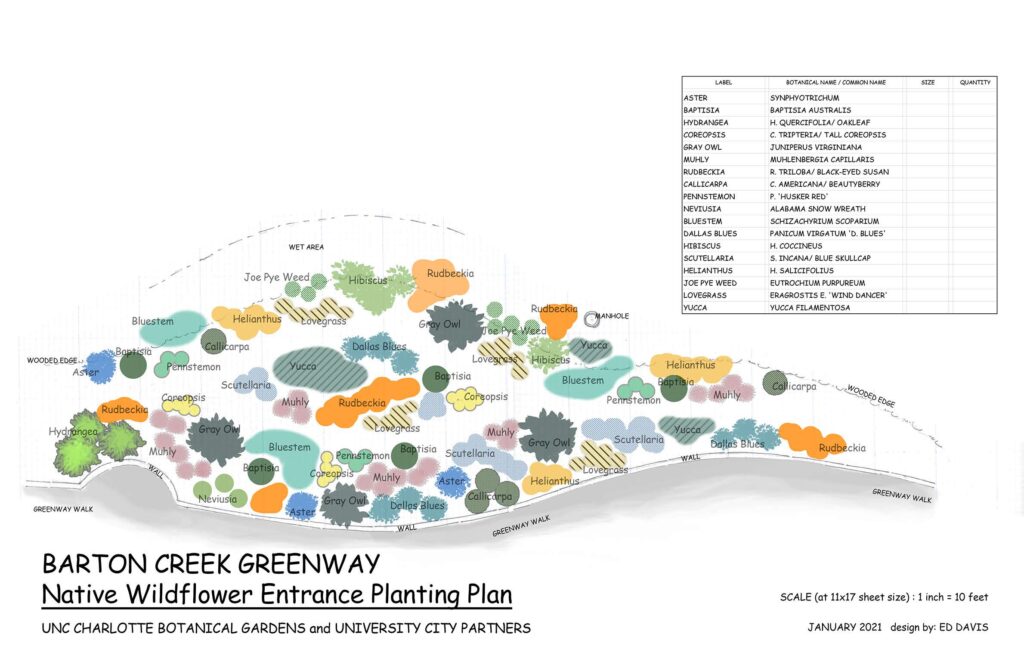
“Native plants are better for the environment and local pollinators, and they are beautiful as well,” Davis said. “We hope that visitors will be inspired by the Barton Creek Native Meadows and incorporate native plants in their own home landscapes and gardens. We are appreciative of the opportunity to work with University City Partners on this project.”
For the UNC Charlotte Pollinator Club, students saw the experience as a great opportunity to extend their mission, said Carrie Wells, club advisor and lecturer in ecology and conservation biology in the Department of Biological Sciences. “We had several folks present at the greenway planting on Sunday from the Pollinator Club, including our vice president, Rachel Magallon, our treasurer Abby Richardson, and a member of the club, Zan Atwell,” Wells said. “We are trying to participate in more community events to increase our impact on helping native pollinators on and around the UNC Charlotte campus. We will be planting at the Jamil Niner Student Pantry as well.”



Chemistry Professor Receives National Award For Excellence In Mentoring Undergraduates’ Research
In the midst of the COVID-19 pandemic and all its challenges for students, 16 undergraduate scholars have found a supportive research home in Chemistry Professor Dan Rabinovich’s lab group. They are among the 144 undergraduates that Rabinovich has mentored throughout his 25 years at UNC Charlotte.
“I have also mentored several visiting undergraduate students from other institutions – and about 50 high school students – and that brings the “big total” to about 250 undergraduate and high school students advised in research during the past 25 years,” Rabinovich says. “I think it’s worth mentioning that I couldn’t have possibly done it all by myself, and I have tremendously benefited from the help of 33 students who were pursuing master’s degrees and have worked in my lab over the years.”
For these significant – and long-standing – contributions to the professional development of undergraduates, and in honor of his own research, Rabinovich has received the top award presented by the American Chemical Society each year to a researcher who mentors undergraduate scholars in an outstanding manner. Research Corporation for Science Advancement sponsors the award.
“I like the challenge of designing projects that can be carried out by students conducting research on a part-time basis, because they are usually full-time students and have many other obligations,” he says.
“I enjoy helping students develop a variety of universal skills that will serve them well in the future regardless of their career goals, such as communication skills through preparation of posters and oral presentations, critical thinking, and time management.”
— Dan Rabinovich
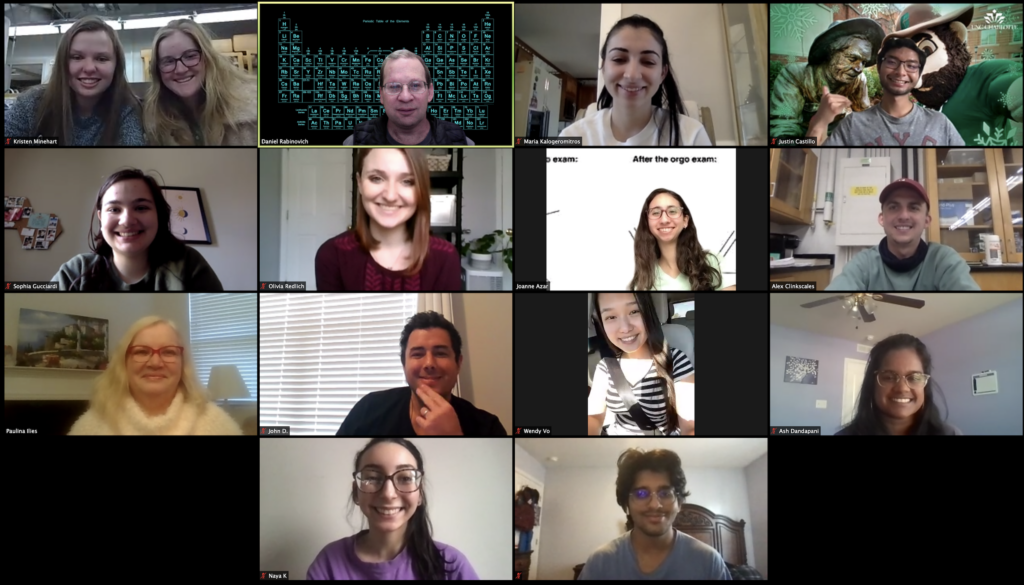
Colleagues commend Rabinovich for challenging students to conduct innovative research, publish their work in scientific journals, and present their work at conferences.
“I have attended research presentations that many of his undergraduate students have made at regional and national ACS meetings, with more than 240 total student presentations from his research group,” says Gregory J. Grant, Grote Professor Emeritus at the University of Tennessee at Chattanooga. “These presentations have always been excellent, and you can clearly see that Dan has prepared them very well. I have been amazed at the quality of inorganic research that Dan has been able to achieve with his high school students.”
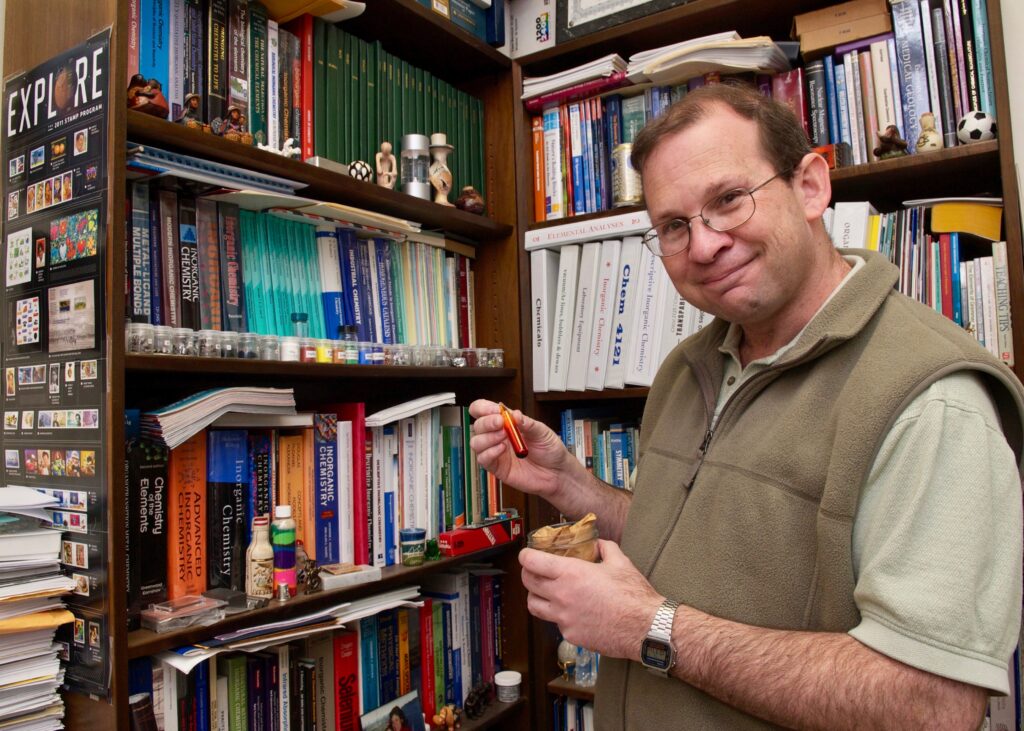
Whether it is to show someone how to use a Schlenk line, analyze the carbon-13 NMR spectrum of a new compound, or discuss an unexpected X-ray structure, it gives him great joy to work with students in the laboratory, Rabinovich says. “When I see a student solve a problem that I considered particularly difficult or carry out an experiment that I thought might not work, I am motivated to push students and myself even further,” he says.
In non-pandemic times, Rabinovich would have joined colleagues in San Antonio, Texas this month for the spring 2021 national ACS conference, where he would have received his award at a black-tie event with what was sure to be thunderous applause. Instead, with the shift to a virtual conference, he delivered an award address via Zoom on Friday, April 9 with the hopes of an in-person ceremony in the fall.
In his usual fashion, rather than show disappointment about a postponed ceremony, Rabinovich chose to see the silver lining. He is proud that his former students organized a symposium in his honor during the virtual conference. Alison Fout ’04, who earned a master’s degree at UNC Charlotte and is now a professor in the Department of Chemistry at the University of Illinois at Urbana-Champaign, took the lead on the symposium.
“I’m super excited about the symposium because participants ranged from former students to Nobel Laureate Roald Hoffmann,” Rabinovich says. “These are all people who I admire and respect.”

Among the alumni participating in addition to Fout were Lizeth (Hernandez) Mendez ’14, ’16, who earned bachelor’s and master’s degrees at UNC Charlotte and started her work with Rabinovich as a high school student; Sam Kyran ’10, who earned a bachelor’s degree at UNC Charlotte and a Ph.D. from Texas A&M University; and Sophie Whitmeyer, who did research in his lab as a high schooler during the summers of 2014 and 2015 and is now pursuing a Ph.D. degree in chemistry at the University of Chicago.
Rabinovich earned a doctoral degree from Columbia University and a bachelor’s degree from Catholic University in Peru. He was a post-doctoral fellow at Los Alamos National Laboratory, and as a faculty member has been a Fulbright Scholar, an IUPAC Young Observer, a Henry Dreyfus Teacher-Scholar, and recipient of the Stanley C. Israel Award for his efforts to advance diversity in the chemical sciences.
The Camille and Henry Dreyfus Foundation, Research Corporation for Science Advancement, the American Chemical Society’s Petroleum Research Fund, and the National Science Foundation have supported his recent research.
Founded in 1876 and chartered by the U.S. Congress, the ACS is one of the world’s largest scientific organizations with more than 155,000 members in 150 countries.
Words: Lynn Roberson, CLAS Communications Director | Images: Lynn Roberson, Wade Bruton and courtesy of Dan Rabinovich
Catch Up With The 2020-2021 Personally Speaking Published Experts Series With Films On YouTube
The Personally Speaking published experts series in its 11th season looked at drones, cats, and Africa. Three UNC Charlotte scholars/researchers in 2020-2021 talks discussed books they have written and how they came to write them during the annual series presented by UNC Charlotte’s College of Liberal Arts & Sciences, J. Murrey Atkins Library, and The Dubois Center at UNC Charlotte Center City.
“We offer this series to engage the community in conversations about relevant topics considered in books written by our faculty,” said Nancy A. Gutierrez, dean of the College of Liberal Arts & Sciences. “Not only is this a way for us to connect with the community, but it also is a way to share knowledge and spark discussion.”
Due to uncertainties related to the COVID-19 pandemic, the events in the 2020-2021 season were virtual presentations, with opportunities for online engagement by the audience from around the world with the authors. Films of the talks are available on the College’s YouTube channel.
James Igoe Walsh presented on Wednesday, September 30, 2020 on his book, Drones and Support for the Use of Force, which he wrote with co-author Marcus Schulzke.
Combat drones offer an unprecedented ability to reduce the costs of conflict by increasing accuracy, reducing the risks to civilians, and protecting military personnel from harm. The advantages should make drone strikes more popular than operations involving ground troops. Yet many critics believe drone warfare will make political leaders too willing to authorize wars, weakening constraints on the use of force.
Walsh, a professor in the Department of Political Science and Public Administration in UNC Charlotte’s College of Liberal Arts & Sciences, was awarded the First Citizens Bank Scholars Medal for 2020. His research interests include armed conflict and civil wars and international security cooperation and conflict. His work has been published by Columbia University Press, the Journal of Conflict Resolution, International Studies Quarterly, among others. Walsh serves as Lead Principal Investigator on the U.S. Defense Department’s Minerva Research Initiative grant supporting a “Resources and Conflict” project.
Co-author Schulzke is a lecturer in international relations at the University of York, United Kingdom.
Beth Elise Whitaker presented on Wednesday, October 28, 2020, on her book, Africa’s International Relations: Balancing Domestic and Global Interests, which she co-authored with John F. Clark.
Why do African leaders cultivate ties with some foreign powers and not others? How do civil conflicts in African countries at times expand to engulf entire regions of the continent? Why have leaders enhanced the capabilities of international organizations like the African Union while undermining the authority of bodies such as the International Criminal Court?
Whitaker is a professor and director of the honors program in the Department of Political Science and Public Administration in UNC Charlotte’s College of Liberal Arts & Sciences. As a Fulbright Scholar in Kenya in 2005-2006, she examined U.S.-African counter-terrorism cooperation. She also has done fieldwork in Tanzania and Botswana. More recently, with a U.S. Department of Defense grant, Whitaker and colleagues have studied how rebel groups’ illicit funding strategies influence the dynamics of civil conflict. Whitaker worked previously at the Brookings Institution and the American Council on Education.
Co-author Clark is a professor of politics and international relations at Florida International University.
Gregory J. Gbur presented on “Falling Felines and Fundamental Physics” on Tuesday, February 23, 2021.
The question of how cats always land on their feet has long intrigued humans. Attempts to understand the cat righting reflex have provided crucial insights into puzzles in mathematics, geophysics, neuroscience, and human space exploration. There is an explanation, but the finer details still inspire heated arguments. And, as with other cat behavior, the more we investigate, the more surprises we discover.
Gbur is a cat parent. He also is a physicist who specializes in the study of classical coherence theory in optical physics and a professor in the Department of Physics and Optical Science in UNC Charlotte’s College of Liberal Arts & Sciences. Gbur runs two different blogs about science and other topics: Skulls in the Stars: The intersection of physics, optics, history, and pulp fiction, and Science Chamber of Horrors: Presenting the freakiest and most terrifying aspects of science, scientists, and nature- currently on hiatus.
College Mourns Loss of Mathematics Faculty Member
UNC Charlotte Professor Emeritus Nickolas (Nick) M. Stavrakas, 74, passed away on March 24, 2021 at Atrium Health University City following a sudden illness. Stavrakas was a professor and administrator in the Department of Mathematics and Statistics for 43 years before retiring in 2015. He served as associate chair for the department in the early 1990s.
Stavrakas was dedicated to UNC Charlotte throughout his career and was also a university alumnus and Charlotte native. He earned a bachelor’s degree in mathematics from UNC Charlotte and played on the men’s basketball team in the 1960s before earning master’s and doctoral degrees in mathematics from Clemson University.
He made clever contributions to mathematics, including convexity theory, throughout his career, which continued after his retirement. Some of his geometric insights made contributions, in collaboration with other colleagues, to other areas such as infinite dimensional topology and general topology.
Colleagues describe Stavrakas as a kind and creative person who worked efficiently, running all things smoothly and with a smile. He saw the best in the department and was a tireless supporter of the faculty and its mission. Some of his most important contributions were connected with the department’s effort to develop and launch the Ph.D. program in mathematics. That program was one of the initial three Ph.D. programs UNC Charlotte was authorized to offer.
His roots in Charlotte and his life-changing experience as an undergraduate at UNC Charlotte fostered a special commitment to the university – his university – shaped his contributions over 40 years on the faculty, colleagues say.
His obituary is available through McEwen Funeral Service at Sharon Memorial Park.
NSF Chooses CLAS Student, Alumnus For Highly Competitive NSF Graduate Research Fellowships
Chemistry undergraduate Terawit Kongruengkit and political science alumnus Anthony Lindsay each will receive a Graduate Research Fellowship from the National Science Foundation. They are among just 12 percent of applicants selected nationwide this year for the highly competitive honor.
In addition to these College of Liberal Arts & Sciences students, two William States Lee College of Engineering students, Forest Atcheson and Christopher Neff, are among the 2,000 students selected from more than 16,000 applicants this year.
Kongruengkit, a member of Professor Jordan Poler’s research group in the Department of Chemistry, is expected to complete a bachelor’s degree in chemistry in spring 2021, with a minor in physics. Kongruengkit plans to enter a doctoral program in materials science and engineering in the fall. His fellowship research will focus on magnonic and magnetic materials research. Magnonic devices hold promise in the fields of space exploration, instrumentation, computing devices and others, through wave-based computing.
Lindsay earned a bachelor’s degree in political science with honors in 2018 and conducted research with UNC Charlotte political scientists Beth Whitaker, Cherie Maestas, and James Walsh. Lindsay is pursuing a doctoral degree in political science at UNC-Chapel Hill, where he was awarded the North Carolina Excellence Fellowship. His NSF fellowship will enable construction of a conflict forecasting engine that he anticipates can help predict interstate conflict, domestic conflict and rare events, such as protests, riots, terrorist attacks, and regime shifts.
The NSF Graduate Research Fellowship Program recognizes and supports outstanding graduate students in NSF-supported science, technology, engineering and mathematics disciplines who are pursuing research-based master’s and doctoral degrees at accredited U.S. institutions.
Fellows benefit from a three-year annual stipend of $34,000 along with a $12,000 cost of education allowance, opportunities for international research and professional development and the freedom to conduct their own research at any accredited U.S. institution of graduate education they choose.
Images: Courtesy of Terawit Kongruengkit (left) and Anthony Lindsay (right.)
Researcher Earns NSF CAREER Award To Support Work With Optical Systems To Find Creative Solutions
UNC Charlotte researcher Rosario Porras-Aguilar is fascinated by light, inspired by its beauty and its usefulness. Specifically, she focuses her pioneering research on how light can enable more accurate quantitative data in fields ranging from microbiology to high-tech manufacturing.
To support her research, Porras-Aguilar this spring received a coveted National Science Foundation Faculty Early Career Development Program (CAREER) Award. “By the end of this project, we will have developed theoretical models and experimental probes of a SMART imaging system,” Porras-Aguilar says. “SMART stands for Specific, Measurable, Accurate, Reconfigurable, and real-Time imaging systems.”
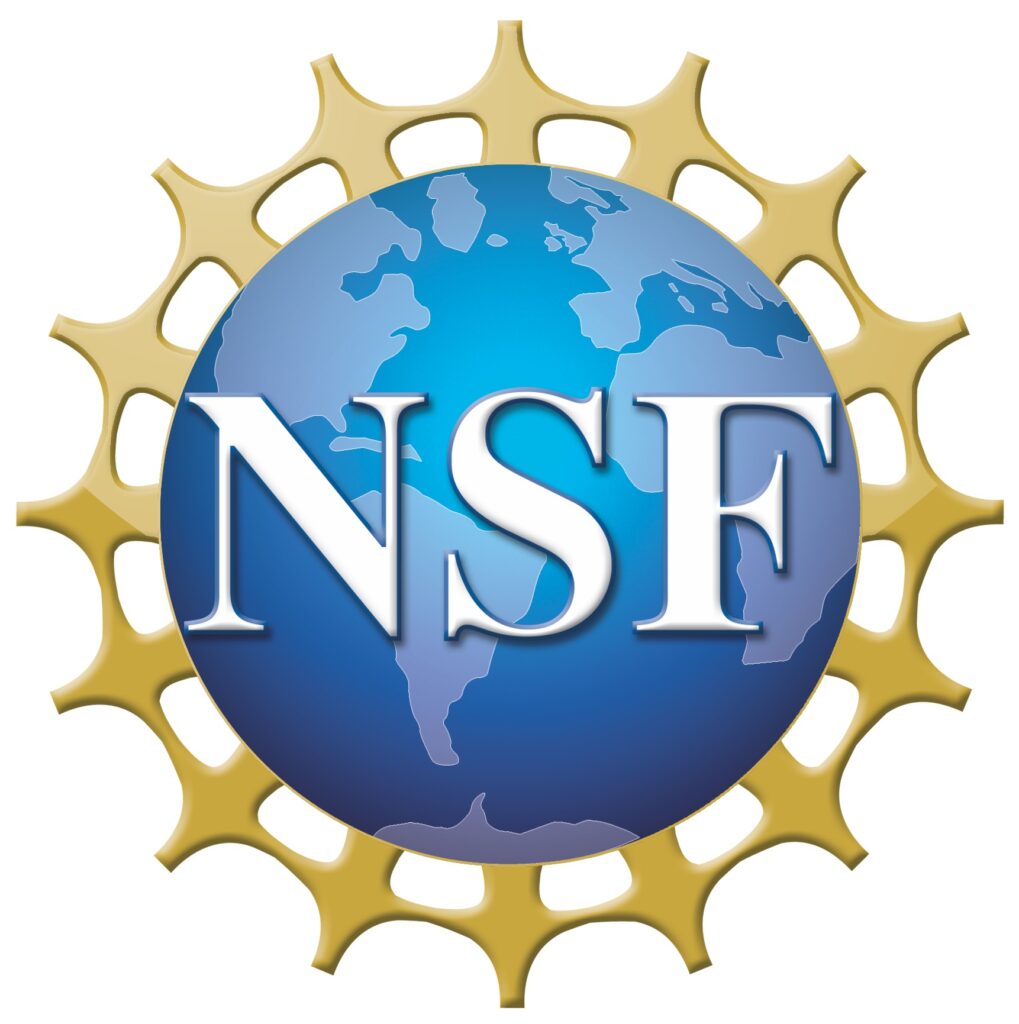
CAREER awards are the NSF’s most prestigious awards in support of early-career faculty who have the potential to serve as academic role models in research and education and to lead advances in the mission of their department or organization. Porras-Aguilar’s anticipated funding is $500,000 through 2026.
Also this spring, she received a 2021 Cottrell Scholar Award, one of 25 outstanding teacher-scholars in chemistry, physics, and astronomy chosen in the United States and Canada. Research Corporation for Science Advancement provides the $100,000 awards, which also offer opportunities for future funding and collaboration on projects with potential national impact.
Broadly speaking, Porras-Aguilar’s Active and Reconfigurable Optics Laboratory conducts research focused on developing microscopy techniques to obtain quantitative data in three dimensions with applications in microbiology and industry.
“My long-term goal is to enable smart imaging systems with reconfigurable capabilities to detect and measure objects that are hard to visualize,” she says. “Examples include transparent cells in biological samples or monitoring small temperature changes in tiny regions of materials for nuclear decay tests.”
Research Holds Important Implications For Medical Diagnoses
In microbiology applications, the research promises the enabling of quantitative observations to provide more accurate and earlier diagnoses of disease. Her research anticipates that automated, speedier and more accurate diagnoses will dramatically improve advances and outcomes in microbiology, personalized medicine, pathology, visual optics, brain imaging and other medical and biological fields.
“One critical challenge in microbiology and pathology is the need for quantitative methods to monitor biological samples,” she says. “Currently, we can use fluorescence microscopy to label and enhance specific areas of interest, but it is time-consuming, costly, and sometimes unreliable. Other cell parameters are currently estimated by the naked eye, leading to imprecise and slow studies.”
A new generation of reconfigurable imaging systems will permit sample analysis automation, she says.
Smart imaging and optical metrology can also impact ultra-precision manufacturing industries. “This research on optical materials is expected to contribute to the development of imaging technology that will significantly impact manufacturing industries, such as the freeform optics industry and additive manufacturing technologies, which will, in turn, promote the economic growth of the United States,” she says.
The applications also can impact national security, and productivity, such as through more effective ways to harness “big data” using artificial intelligence and machine learning algorithms. Porras-Aguilar is co-principal investigator for several research projects with the Center for Freeform Optics and the Center for Precision Metrology.
Porras-Aguilar’s fascination with light began years ago, by looking at the stars at night. “Professionally, my interest in optics began during my master’s in astronomy studies when I learned about telescopes that can compensate for the deformation in images induced by changes in the atmosphere,” she says.
She completed her doctoral studies in optics science at the National Institute in Astrophysics, Optics, and Economics. “I found myself learning about intriguing liquid crystal materials,” she says. “With these materials, it is possible to control light and open doors to applications, including microscopy.”
“I found that astronomical images in the macro-universe are just as mesmerizing as the ones we can find in the micro-universe.”
— Rosario Porras-Aguilar
Seeking a CAREER Award appealed to Porras-Aguilar not only because of its potential to fund her research; she also was drawn by its emphasis on educating future generations.
“I have always been passionate about research and education,” she says. “Since the first time I learned about this award, I saw it as an opportunity to consolidate my career and open doors to younger generations of scientists.”
Porras-Aguilar feels the sense of trust that comes along with being selected for a CAREER award. “I highly appreciate the vote of confidence given to me by the National Science Foundation, UNC Charlotte, and the Department of Physics and Optical Science,” she says. “It is not only motivating but also a commitment to excellence and integrity.”
Cross-Disciplinary Collaboration Helps Advance Research
She specifically credits mentors in her department with helping her advance her research, including department Chair Glenn Boreman, and more recently, longtime researcher Michael Fiddy, as well as UNC Charlotte Research and Economic Development’s Catalyst bootcamp and collaborators across the University.
“Collaboration is crucial in my research because it is cross-disciplinary,” she says. “One part of my research has applications in the metrology of samples for the manufacturing industry and free-form optics. I collaborate with Dr. Konstantinos Falaggis from the Mechanical Engineering and Engineering Science Department on this subject. I also collaborate with Dr. Juan Vivero-Escoto from the Chemistry Department to use the imaging techniques that I develop to study biological samples.”
She also commends students for their involvement and their influence. “Students are key to our scientific productivity because teamwork is essential to achieve our goals,” she says. “It is gratifying as a mentor to see students mature and contribute with new ideas and findings.
Porras-Aguilar has long embraced diversity and inclusion efforts, committing time and leadership with SPIE, its Women In Optics initiative and other efforts. Convinced that outreach activities can convey a message with gender equality, she was the official advisor of the SPIE Women in Optics Chapter at INAOE in Puebla, Mexico and continued to advise the student chapter until August 2018, despite her relocation to UNC Charlotte in 2017.

“Diversity and excellence are crucial to advance any field, and particularly science,” she says. “If science is benefited, humanity is benefited as well. Unfortunately, many populations are underrepresented in STEM areas. These underrepresented groups are the ones that face social and/or economic disadvantages.”
Her CAREER project includes an educational component centered on students and diversity. The work will include hands-on research and mentoring experiences in physics and photonics for high-school students and teaching strategies to foster the curiosity and talent of undergraduates, especially those from groups traditionally underrepresented, including Hispanics and women.
Porras-Aguilar plans to collaborate with the Center for STEM Education at UNC Charlotte, the LatinX/Hispanic Faculty Staff Caucus at UNC Charlotte, and the Physics Undergraduate Mentoring Program (PUMP) from the Department of Physics and Optical Science.
“Visibility and mentoring are the two proven solutions that have been reported in various studies to break the stereotype of a scientist in STEM areas,” she says. This commitment is key to her research and to her passion for sharing the light.
Words: Lynn Roberson, CLAS Communications Director | Top Image: Kat Lawrence, University Photographer | Other Image Courtesy of Rosario Porras-Aguilar
Chemist Conducts Innovative Energy Research, Earning Coveted NSF CAREER Award
With demand growing for renewable energy and for novel energy storage options, UNC Charlotte chemist Christopher Bejger is conducting innovative research that holds promise for new solutions.
To support his research, Bejger this spring received a National Science Foundation Faculty Early Career Development Program (CAREER) award. CAREER awards are the NSF’s most prestigious awards in support of early-career faculty who have the potential to serve as academic role models in research and education and to lead advances in the mission of their department or organization. Bejger’s anticipated funding is $624,000 through 2026.
The CAREER award work will focus on developing a new class of metal-organic frameworks made up of transition metal chalcogenide (TMC) molecular clusters. The proposed frameworks are relevant to the study of high surface nanoelectronics and future charge storage devices.
The research offers a new synthetic approach, constructing porous crystalline frameworks from TMC cluster building blocks. Bejger describes the work as constructing multidimensional materials using nanoscale building blocks.
The CAREER award follows on the heels of a previous National Science Foundation award of $456,394 in April 2020.
Broadly speaking, Bejger’s various research efforts center on developing hybrid materials for energy applications and investigating new compounds for energy storage.
Bejger Research Group Drives Innovation In Renewable Energy
“We need to integrate renewable energy sources into the energy grid to transition away from fossil fuels,” Bejger says. “But because renewable energy sources are intermittent, storage devices are required to power the grid when the sun isn’t shining or the wind isn’t blowing. In my lab, we’re using organic chemistry to prepare molecules that can operate in salt water and can be used to make safe, economical, and more efficient batteries.”
To start with the basics, here’s a quick battery lesson from Bejger.
A redox flow battery uses chemicals that are dissolved in a solution. “The chemicals are pumped through a system you can charge up when you pump the chemicals one direction and then store them in a tank,” he says. “And then later, you can pump the solution back in the opposite direction, and the chemicals inside release their charge.”
While redox flow batteries have been around since the 1960s, they present significant issues. They traditionally use expensive metals, such as vanadium. The systems usually use a highly corrosive solution like sulfuric acid to dissolve the vanadium. They are usually pretty big systems, meaning space can be an issue.
In contrast, the Bejger Research Group’s work is forging a revolutionary approach focused on solutions that are less expensive and greener.
“What we’re using in our research are organic molecules, consisting of only carbon, hydrogen, oxygen, and nitrogen,” Bejger says. “You can actually tune the molecules, so you can increase the solubility. You can change some of their properties so that you can get higher voltages or more than one electron so that you could hold more charge.”
The molecules operate at pH 7. That means they can operate in pure, or neutral, water, which has neither acidic nor basic qualities.
“There really are very few organic molecules that can work in long-term energy storage flow batteries,” Bejger says. “The majority of them still do not work at neutral pH. What we are using is just regular water. If you have a battery in water, commonly you need an electrolyte, so you have low resistance in your battery. So, ours actually work with just regular salt as that electrolyte.”
Bejger, an assistant professor in the Department of Chemistry, joined UNC Charlotte’s faculty in 2015, after a stint as a Camille and Henry Dreyfus Environmental Chemistry Postdoctoral Fellow at Columbia University. He earned a bachelor’s degree in chemistry from the University of Oregon and a doctoral degree in chemistry from the University of Texas in 2012. During his graduate studies, he was a Seaborg Graduate Fellow at Los Alamos National Laboratory from 2010-2012.
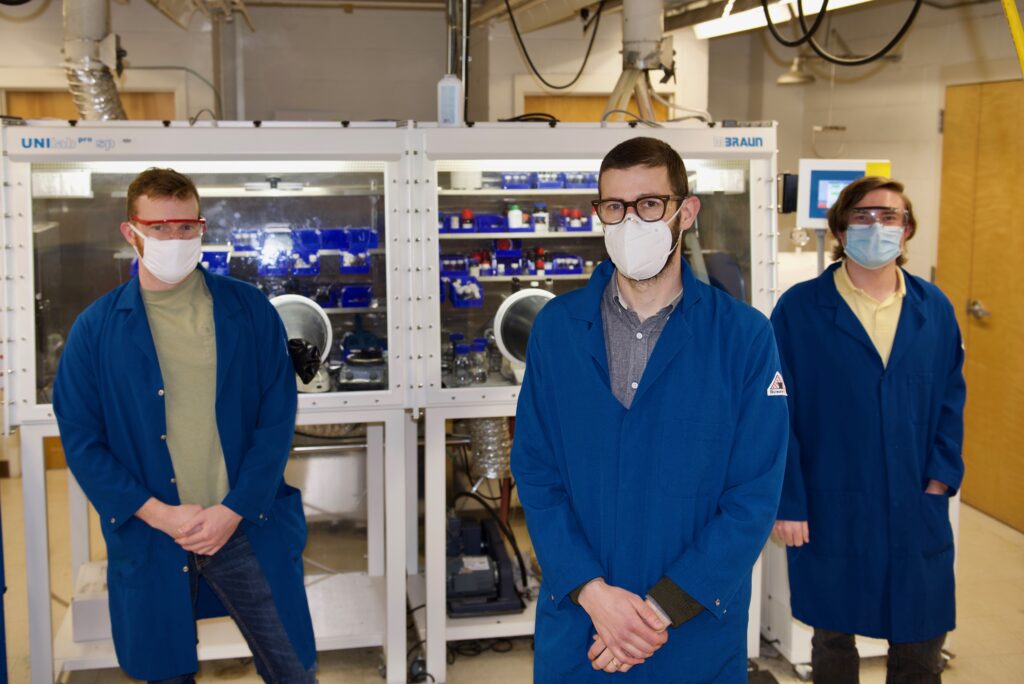
Bejger started his UNC Charlotte lab with one master’s degree student, Jessica Shott, and one undergraduate student, Matthew Freeman, who stayed with the lab through the completion of a master’s degree in chemistry.
They laid the initial foundation for the lab’s work, starting with molecular cluster research.
“They’re like little nano spheres that also have this ability to hold electrons,” Bejger says. “But what was interesting about those is that they can hold one, two or three electrons. So you’re starting to get into the position where you can put a lot of electrons into one molecule and take them out and put them back in without disturbing the molecule in any way.”
In this early work, Bejger saw potential for the molecular clusters to act as energy storage materials that could store more than one electron, which would be efficient.
The team published their findings, but they also hit limitations because the material was just too heavy, and it would not dissolve enough in the solution to store enough energy to be practical. Nick Turner, who is a degree candidate in the master’s program in Chemistry, joined the team early on, and other students applied as research associates.
Bejger and the students tinkered with smaller and smaller molecules. They began working with a class of compounds called radialenes, which are star-shaped organic molecules. They found the molecules worked well in water, which led to the research proposal that the NSF funded in 2020. The research team has produced a number of papers, including one that was featured on the front cover of Chemistry A European Journal.
The early success working with undergraduate students led Bejger to include undergraduate components in his first project funded by the NSF in 2020. Working with faculty colleagues Mitchell Anstey of Davidson College and Todd Coolbaugh of Johnson C. Smith University, the project is focusing on research into radialene molecules.
The three-institution team is planning to build an interactive exhibit on redox flow batteries to expand awareness of grid-scale renewable energy storage. Students involved in the research will work across the institutions with faculty members and a regional industry partner. While COVID-19 restrictions have shifted some of the work, the outreach and student research are slated for this coming year.
“We decided that it would be really cool to build an actual working prototype of one of these batteries on a small scale that we could take to local schools and teach people about this type of energy storage technology,” Bejger says.
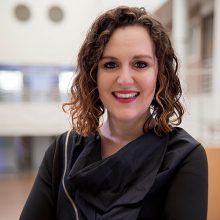
The CAREER award efforts also will include substantial involvement by students and the community. Bejger and chemistry students will work with architecture assistant professor Rachel Dickey and architecture students to design and build an interactive Nanoscale Materials Pop Up Museum to communicate chemistry and nanoscale science at community events, schools and other opportunities. Bejger and Dickey plan to work with the Charlotte Teachers Institute on a Summer Research Experience for Teachers, with a handful of teachers immersed in the work. With CTI, they plan to also co-lead a seminar for a group of Charlotte-Mecklenburg Schools teachers called “Design Matters.”
Particularly as an early career faculty member, Bejger has called upon the extensive expertise and collaborative spirit at UNC Charlotte, especially in his home department.
“In a lot of ways I don’t know if this project could have worked, if I wasn’t lucky enough to start my career here,” he says. “I am more of a synthetic chemist, and I’m not an expert in energy storage or even in electrochemistry, which is the study of how molecules can be charged and discharged and how they behave electronically. But it just happens that in this department, there are a lot of faculty that are electrochemists by training.”
Another colleague, Dan Jones, has been in the department perhaps longer than any other faculty member, and is an x-ray crystallographer, which is another specialty area that has benefitted Bejger’s work.
Chemistry Master’s Degree Program Brings Talent Into Bejger’s Lab
The intensive chemistry master’s degree program has been essential to the work, Bejger says. “We are unique at UNC Charlotte, because we have a research based chemistry master’s program where students can come and really focus on research for two years and write a thesis at the end of that. That’s helped me design projects that can be completed by master’s students.”
Communicating with non-chemists and students who are not chemistry majors about his field and his research is important to Bejger. While he certainly aspires to solve world problems with applied research, he also finds time for exploration and reflection.
“In my lab, we want to kind of be nerds and look at all the weird chemistry of new materials and be fascinated and discover things serendipitously,” he says. “But we also want to solve problems. It’s important to understand that chemistry is important to solving a lot of the world’s problems.”
Yet, the architecture and design of the materials he makes inspire him, and – he hopes – others around him.
“I’ve always been fascinated by the beauty and the aesthetics of chemistry and the design aspects of synthesis,” he says. “Some people are really interested in the real difficult math and analytical nature of chemistry. But I’ve always been more attracted to the artistic and inspired design elements of chemistry. And that’s what we’re trying to do.”
Words and Images: Lynn Roberson, CLAS Communications Director
Nontraditional Student Megan Mitchem Changes Face of Research
Nontraditional student Megan Mitchem is changing the face of research inside and outside the lab.
M.S. in Math Finance Soars To Highest Level Ever In TFE Times National Ranking
UNC Charlotte’s Master of Science in Mathematical Finance program has once again been named among the top-ranked programs in the nation, ranking No. 12 in the TFE Times’ 2021 Master of Financial Engineering program rankings.
Over the past six years, the M.S. in Math Finance program has increased steadily in the rankings, rising eight slots since 2016, according to TFE Times. As a STEM-designated program of the Departments of Finance and Economics in the Belk College of Business and the Mathematics and Statistics Department in the College of Liberal Arts & Sciences, the program excels in readying students for careers in an emerging field.
“The Master of Science in Mathematical Finance is intelligently designed to prepare students for finance careers that increasingly demand more math and data skills, particularly in financial institutions, investment banks, and commodities firms,” said Taufiquar Khan, chair of the Department of Mathematics and Statistics.
“These careers require proficiency in the application of highly sophisticated mathematical models to identify, measure, and manage risk,” Khan said. “The expertise of mathematics faculty, as well as that of faculty in economics and finance, offers an interdisciplinary collaboration that has delivered strong results for our students and for employers.”
The program’s responsiveness to industry’s needs for talent and insights is particularly important for Charlotte’s spot as the second-largest banking center in the United States.
Over the last three years, 95% of M.S. in Math Finance alumni are employed within three months of graduation, according to First Destination Survey data. The growth of the program’s success is a testament to exceptional faculty, combined with a customizable interdisciplinary approach, said Yufeng Han, M.S. in Math Finance program director.
CLAS faculty teaching in the M.S. in Math Finance program are Jaya Bishwal, an expert in stochastic analysis and computational finance; Aziz Issaka, an authority in mathematical finance and stochastic calculus; and Adriana Ocejo Monge, an expert in mathematical finance and actuarial science.
The TFE Times rankings are the most comprehensive for graduate financial engineering, financial mathematics, quantitative finance, computational finance and mathematical finance programs in the country. The rankings are calculated based on several components, including average test scores, starting salaries, undergraduate GPA, acceptance rates and graduate employment rates.
